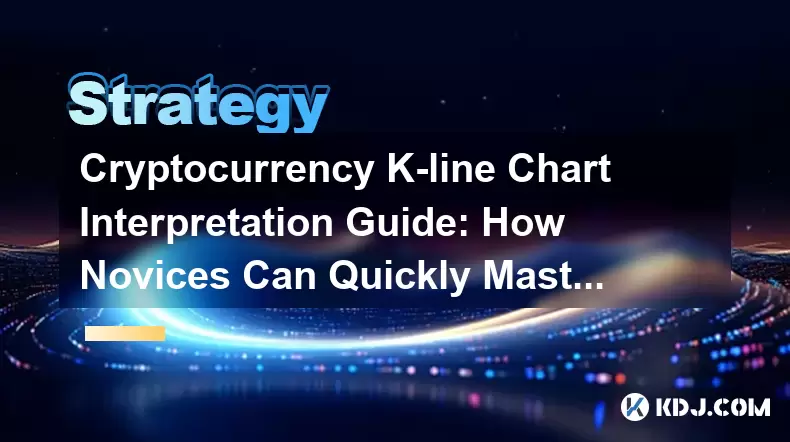-
 bitcoin
bitcoin $123963.239194 USD
1.37% -
 ethereum
ethereum $4529.082464 USD
1.07% -
 xrp
xrp $2.983640 USD
0.71% -
 tether
tether $1.000287 USD
0.02% -
 bnb
bnb $1179.874393 USD
2.99% -
 solana
solana $230.633678 USD
1.55% -
 usd-coin
usd-coin $0.999835 USD
0.03% -
 dogecoin
dogecoin $0.254240 USD
1.34% -
 tron
tron $0.341176 USD
0.15% -
 cardano
cardano $0.842285 USD
0.52% -
 hyperliquid
hyperliquid $48.537896 USD
-0.86% -
 chainlink
chainlink $21.863092 USD
-0.84% -
 ethena-usde
ethena-usde $0.999743 USD
-0.07% -
 sui
sui $3.579561 USD
-0.18% -
 stellar
stellar $0.403418 USD
2.67%
Cryptocurrency K-line Chart Interpretation Guide: How Novices Can Quickly Master the Basics of Technical Analysis
K-line charts reveal price trends and reversals through candlestick patterns, helping traders spot opportunities when combined with volume and other indicators.
Jun 10, 2025 at 08:56 pm

Understanding the Basics of K-line Charts
K-line charts, also known as candlestick charts, are one of the most widely used tools in cryptocurrency trading for analyzing price movements. Each K-line represents a specific time period and shows the opening, closing, high, and low prices during that interval. For novices, grasping how to read these elements is crucial.
The body of the K-line indicates the range between the opening and closing prices. If the closing price is higher than the opening price, the body is usually green or hollow, signifying a bullish trend. Conversely, if the closing price is lower, the body appears red or filled, representing a bearish movement. The wicks or shadows above and below the body reflect the highest and lowest prices reached during the period.
Understanding this basic structure allows beginners to interpret short-term market sentiment and potential reversals. It's essential to practice identifying these patterns across different timeframes, such as 1-hour, 4-hour, or daily charts, to build familiarity.
Common K-line Patterns and Their Meanings
Once you've understood the anatomy of a K-line, the next step is recognizing common patterns that appear on the chart. These patterns help traders anticipate future price movements based on historical behavior. Some of the most frequently observed candlestick formations include:
- Doji: A candle with almost equal open and close prices, indicating indecision in the market.
- Hammer: A candle with a long lower shadow and small body at the top, suggesting a potential reversal from a downtrend.
- Shooting Star: The opposite of a hammer, appearing after an uptrend and signaling a possible reversal.
- Engulfing Pattern: A two-candle formation where the second candle completely engulfs the first, often indicating strong momentum in the direction of the second candle.
Learning to identify these patterns can provide valuable insights into market psychology, helping beginners make informed decisions about entry and exit points.
Reading K-line Charts Across Timeframes
One of the keys to mastering technical analysis is learning how to interpret K-line charts across various timeframes. Shorter timeframes like 5-minute or 15-minute charts offer more frequent signals but can be noisy and prone to false breakouts. On the other hand, longer timeframes such as daily or weekly charts provide clearer trends but fewer trading opportunities.
When analyzing a cryptocurrency pair, it's beneficial to start with a higher timeframe to determine the overall trend before zooming into a lower timeframe for precise entry points. For example, if the daily chart shows a bullish trend, a trader might look for buy setups on the 4-hour or 1-hour chart.
It’s important to note that no single timeframe guarantees success. Combining multiple timeframes can reduce risk and increase the probability of successful trades by aligning with broader market directions.
Using Volume Alongside K-line Charts
Volume is an essential companion to K-line chart analysis. High volume accompanying a particular candle suggests strong market participation and increases the reliability of the signal provided by that candle. Conversely, low volume may indicate weak interest and could mean that the price movement lacks conviction.
Many trading platforms display volume bars beneath the K-line chart, showing the number of transactions during each interval. A sudden spike in volume during a breakout or reversal pattern often confirms the strength of that move.
Traders can use volume indicators like On-Balance Volume (OBV) or Volume Weighted Average Price (VWAP) to further validate their interpretations. Incorporating volume analysis helps filter out false signals and improves decision-making accuracy.
Integrating K-line Analysis with Other Technical Tools
While K-line charts are powerful on their own, combining them with other technical indicators enhances their effectiveness. Popular tools such as Moving Averages, Relative Strength Index (RSI), and Bollinger Bands complement K-line analysis by offering additional context.
- Moving Averages smooth out price data and help identify support and resistance levels.
- RSI measures overbought or oversold conditions, which can confirm potential reversals indicated by certain candlestick patterns.
- Bollinger Bands highlight volatility and can show when prices are reaching extreme levels relative to recent performance.
Using these tools together provides a more holistic view of the market, allowing novice traders to make better-informed decisions based on confluence rather than isolated signals.
Frequently Asked Questions
What should I do if a K-line pattern suggests a trade, but the volume is low?
If a K-line pattern suggests a trade opportunity but the volume is unusually low, it's generally advisable to wait for confirmation. Low volume often means lack of market consensus, so entering a trade based solely on such a signal can be risky. You might want to monitor the next few candles or check other indicators before proceeding.
Can K-line patterns work effectively in sideways markets?
Yes, K-line patterns can still provide useful insights in sideways or ranging markets. Patterns like Doji, Spinning Tops, and Inside Bars become particularly relevant as they signal indecision or consolidation. Traders can use these patterns to anticipate potential breakouts once the price moves beyond key support or resistance levels.
How do I differentiate between a genuine K-line reversal and a fakeout?
Differentiating between a real reversal and a fakeout involves looking at several factors:
- Check if the pattern forms near a significant support or resistance level.
- Confirm with increased volume during or after the candle formation.
- Use additional technical indicators like RSI or MACD to verify momentum shifts.
Fakeouts often occur without strong supporting evidence, while genuine reversals tend to align with broader market structure and volume dynamics.
Is it possible to rely solely on K-line charts for trading decisions?
While K-line charts are highly informative, relying solely on them can lead to missed opportunities or false signals. For best results, integrate K-line analysis with volume metrics and other technical tools to form a well-rounded strategy. This multi-dimensional approach reduces reliance on any single indicator and improves the consistency of your trading outcomes.
Disclaimer:info@kdj.com
The information provided is not trading advice. kdj.com does not assume any responsibility for any investments made based on the information provided in this article. Cryptocurrencies are highly volatile and it is highly recommended that you invest with caution after thorough research!
If you believe that the content used on this website infringes your copyright, please contact us immediately (info@kdj.com) and we will delete it promptly.
- BlockDAG, DOGE, HYPE Sponsorship: Crypto Trends Shaping 2025
- 2025-10-01 00:25:13
- Deutsche Börse and Circle: A StableCoin Adoption Powerhouse in Europe
- 2025-10-01 00:25:13
- BlockDAG's Presale Buzz: Is It the Crypto to Watch in October 2025?
- 2025-10-01 00:30:13
- Bitcoin, Crypto, and IQ: When Genius Meets Digital Gold?
- 2025-10-01 00:30:13
- Stablecoins, American Innovation, and Wallet Tokens: The Next Frontier
- 2025-10-01 00:35:12
- NBU, Coins, and Crypto in Ukraine: A New Yorker's Take
- 2025-10-01 00:45:14
Related knowledge

Practical parameter settings for a Bitcoin multi-timeframe moving average system
Sep 18,2025 at 10:54pm
Optimizing Timeframe Combinations for Bitcoin Trading1. Selecting appropriate timeframes is crucial when building a multi-timeframe moving average sys...

How can I filter out false breakouts in Dogecoin high-frequency trading?
Sep 22,2025 at 01:00am
Understanding False Breakouts in Dogecoin Trading1. A false breakout occurs when Dogecoin's price appears to move beyond a defined support or resistan...

Techniques for identifying tops and bottoms in the Bitcoin on-chain NVT model
Sep 20,2025 at 07:54pm
Understanding the NVT Model in Bitcoin Analysis1. The Network Value to Transactions (NVT) ratio is often described as the 'P/E ratio' of the cryptocur...

What does the surge in open interest in Bitcoincoin futures mean?
Sep 20,2025 at 11:18pm
Understanding the Surge in Dogecoin Futures Open Interest1. A surge in open interest within Dogecoin futures indicates a growing number of active cont...

How can I use the Ethereum USDT premium to gauge market sentiment?
Sep 18,2025 at 11:55pm
Understanding the Ethereum USDT Premium1. The Ethereum USDT premium refers to the price difference between USDT (Tether) traded on Ethereum-based plat...

What should I do if Ethereum staking yields decline?
Sep 20,2025 at 06:18am
Understanding the Causes Behind Declining Ethereum Staking Yields1. The Ethereum network transitioned to a proof-of-stake consensus mechanism with the...

Practical parameter settings for a Bitcoin multi-timeframe moving average system
Sep 18,2025 at 10:54pm
Optimizing Timeframe Combinations for Bitcoin Trading1. Selecting appropriate timeframes is crucial when building a multi-timeframe moving average sys...

How can I filter out false breakouts in Dogecoin high-frequency trading?
Sep 22,2025 at 01:00am
Understanding False Breakouts in Dogecoin Trading1. A false breakout occurs when Dogecoin's price appears to move beyond a defined support or resistan...

Techniques for identifying tops and bottoms in the Bitcoin on-chain NVT model
Sep 20,2025 at 07:54pm
Understanding the NVT Model in Bitcoin Analysis1. The Network Value to Transactions (NVT) ratio is often described as the 'P/E ratio' of the cryptocur...

What does the surge in open interest in Bitcoincoin futures mean?
Sep 20,2025 at 11:18pm
Understanding the Surge in Dogecoin Futures Open Interest1. A surge in open interest within Dogecoin futures indicates a growing number of active cont...

How can I use the Ethereum USDT premium to gauge market sentiment?
Sep 18,2025 at 11:55pm
Understanding the Ethereum USDT Premium1. The Ethereum USDT premium refers to the price difference between USDT (Tether) traded on Ethereum-based plat...

What should I do if Ethereum staking yields decline?
Sep 20,2025 at 06:18am
Understanding the Causes Behind Declining Ethereum Staking Yields1. The Ethereum network transitioned to a proof-of-stake consensus mechanism with the...
See all articles










































































